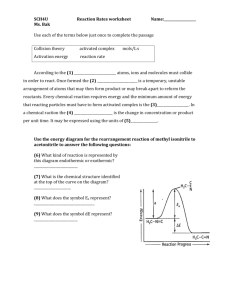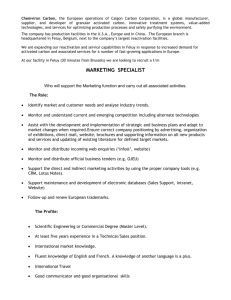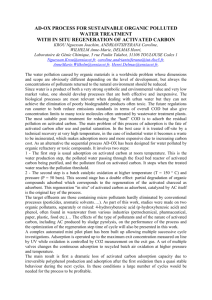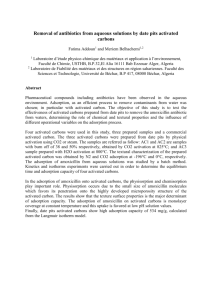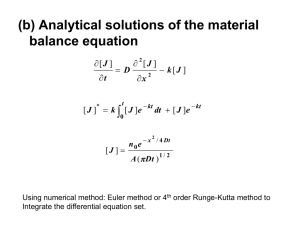Development of novel adsorbents and catalysts based on - sgitt-otri
advertisement
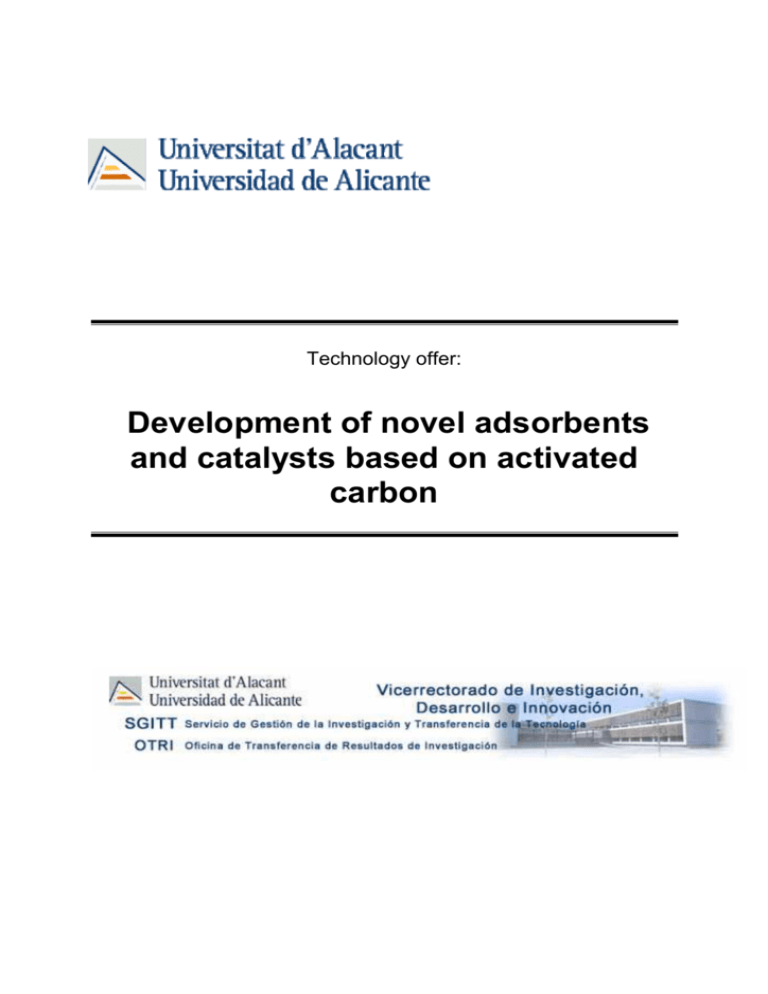
Technology offer: Development of novel adsorbents and catalysts based on activated carbon Technology offer: Development of novel adsorbents and catalysts based on activated carbon SUMMARY The Advanced Materials group (LMA) of the Department of Inorganic Chemistry at the University of Alicante has a vast expertise in the development, characterisation and application of adsorbents, mainly activated carbon. Many of the adsorbents have been developed for specific applications, covering gas storage, separation and purification of gas mixtures, removal of toxic agents and atmospheric contaminants, catalysis, etc. Furthermore, many of the adsorbents have been developed under different physical forms, ranging from powdered and granular to pellets, monoliths and cloths, thus increasing the possibilities of use in different industrial applications. The preparation of the adsorbent is first carried out at laboratory level and, when needed, the process is scalated into pilot plant. Three pilot plants are available for the preparation of different types and forms of adsorbents. TECHNICAL DESCRIPTION The use of adsorbents such as activated carbon is continuously increasing as a consequence of the implementation and enforcement of environmental regulations which have driven demand for water and air filtration based on activated carbon. The constantly increasing demands for purity of natural and synthetic products are also responsible for the need of new adsorbents. Activated carbon is the collective name for a group of porous carbons manufactured to exhibit an extraordinarily large internal surface area and pore volume. Their manufacture is by either treatment of a char with oxidising gases, or by carbonisation of carbonaceous materials with simultaneous activation by the action of a chemical. The unique characteristics of activated carbon are responsible for its adsorptive properties, which are exploited in many liquid- and gas-phase applications. Activated carbon is a very versatile adsorbent because the size and distribution of the pores within the carbon structure can be controlled to meet the needs of current and emerging markets. The main application of activated carbon is the removal of impurities from gases and liquids and it is now established that such a removal takes place through an adsorption process. The surface of the activated carbon can bind molecules from the gaseous or liquid phases by predominantly physical forces of the van der Waals type, causing a high concentration at the interface. There is, additionally, the possibility of SGITT-OTRI (University of Alicante) Phone.: +34965903467 Fax: +34965903803 E-mail: otri@ua.es 2 chemisorption caused by stronger bonding forces on the so-called active sites of the carbon surface. This makes activated carbon a very useful adsorbent in many industrial applications. Although activated carbon is considered to be a general adsorbent, the new applications demanded by the advancing industrial technology require more and more sophisticated materials, and the LMA group has contributed to many developments in this area, as shown below. Conventional and special activated carbon. The LMA group has devoted many research efforts to show that it is possible to manufacture many different types of activated carbon from a common precursor by an adequate control of the preparation conditions. A typical example of this control of the process can be found in Figure 1, where the adsorption isotherms of n-butane at 273K on a series of carbons prepared from peach stones. The shape of the adsorption isotherm is a direct indication of the pore size distribution, and the variety of shapes indicate that the porosity can be tailored according to the specific application of the carbon. The knowledge of the variables implied in the manufacturing process can also be used to the design of new types of adsorbents requested by industry. A rotary furnace pilot plant (Figure 2) is available for the scalation of the laboratory processes. 1.4 1.2 liq/ g) 3 V (c m 1.0 0.8 0.6 0.4 0.2 0 0 0.2 0.4 0.6 0.8 1.0 p/p0 Figure 1. Adsorption isotherms on activated carbons from a common precursor. Figure 2. Rotary furnace pilot plant. Activated carbons for gas storage. In this particular case, the adsorbent has to be prepared in such a way that it is almost exclusively constituted by micropores of around 0.8 nm and solid carbon to ensure a very high pore volume and a high bulk density. This is the only way in which a large gas delivery can be accomplished (for instance, above 160 vol/vol for the case of natural gas storage). In order to obtain such adsorbent, the approach of the LMA group has been to use lignocellulosic precursors (olive and peach stones, coconut shells, etc), subjected to chemical activation and conformed (without the SGITT-OTRI (University of Alicante) Phone.: +34965903467 Fax: +34965903803 E-mail: otri@ua.es 3 use of a binder) to solid monoliths of high density. The monoliths (Figure 3) can be further activated by controlled reaction with carbon dioxide or steam. Figure 3. Solid monoliths of activated carbon. Carbon molecular sieves (CMS). CMS constitute a relatively new type of activated carbon, able to compite with inorganic molecular sieves such as zeolites because they are stable in acidic or basic media, they are not hydrophilic, the microporosity is slit-shaped, and they can be manufactured at relatively low cost. Gas separation is the main application of CMS, but because of their shape selectivity they offer great potential in purification processes and as catalysts and catalyst supports. The approcah used by the LMA group is based on lignocellulosic materials (peach stones, coconut shells, etc.), which are subjected to a special carbonisation process to produce a char with relatively high yield, which is later subjected to a controlled thermal activation to open the microporosity. CMS with micropore dimensions ranging from 0.3 to 0.7 nm can be prepared in this way, thus allowing their use in different gas separation processes. Additionally, some other treatments have been used to prepare CMS, these including carbon deposition in a CMS of relative large micropore size to reduce the opening of the micropore to the selected dimension, and fixation of heteroatoms in the entrance of the micropores to produced the desired narrowing. Activated carbon cloth (ACC). To meet the engineering requirements of specific applications, activated carbons must be manufactured in the form of cloth or felt to benefit from its low pressure drop, high contact efficiency, flexibility and high adsorption capacity. The LMA group has a long experience in the development of ACC, mainly from viscous rayon cloth. Both thermal (carbonisation followed by gasification) and chemical (heat treatment after impregnation of the cloth with a Lewis acid solution) activation have been used, but the best results were obtained by combinning chemical and thermal activation. The process has been scalated to a pilot plant (Figure 4), which permits the continuous preparation of activated carbon cloth. SGITT-OTRI (University of Alicante) Phone.: +34965903467 Fax: +34965903803 E-mail: otri@ua.es 4 Figure 4. Pilot plant for the manufacture of activated carbon cloth. Impregnated activated carbon. Although activated carbon is the adsorbent of choice for the removal of many substances from air by physical adsorption, when the boling point of the vapor is below about 40ºC activated carbon is usually impractical as a physical adsorbent (other adsorbents such as silica gel or activated alumina have a greater affinity for water and therefore are not practical for use with moist air streams). Examples of such low-boiling point toxic or odorous gases are hydrogen sulphide, methyl mercaptan, trimethylamine, arsine, etc. In such cases, a good approach is to impregnate the activated carbon with a chemical that converts the gases into products that are more strongly adsorbed or to impregnate it with a catalysts that promotes the oxidation (in air) of the gases to fixed or harmless products. The LMA group has a long experience in the impregnation of activated carbon (either granular or in the form of cloth) with chemicals and catalysts for the removal of toxic or atmospheric contaminants. In some cases the preparation does not involve impregnation, but the treatment of the activated carbon with a specific chemical to introduce heteroatoms into the carbon surface, thus facilitating the catalytic effect. Activated carbon monoliths. Solid monoliths are used in applications such as gas storage, in order to decrease the interparticle spaces and to optimise the adsorption capacity (volume por volume) of the activated carbon. In some other applications monoliths must have fine parallel channels through which the gas or liquid are circulated. These monoliths have the advantage over conventional granular activated carbon of producing a much lower presure drop through the bed for equal quantities of adsorbent and, furthermore, there is no attrition during use. The MLA group has developed this type of monoliths (Figure 5) using an appropriate mixture of powdered activated carbon and a suspension of small particle size sepiolite, which acts as a binder. The resulting monoliths (they can also be prepared in the form of pellets of different diameter) have the advantage that the binder does not fill or block the microporosity of the binder, although the surface area and porosity of the monoliths is somewhat lower than for the activated carbon alone (the surface area of the sepiolite is lower than for the activated carbon). Not only the monoliths (or pellets) are consistent enough to be used in gas- and liquid-phase SGITT-OTRI (University of Alicante) Phone.: +34965903467 Fax: +34965903803 E-mail: otri@ua.es 5 adsorption processes, but in practice they are multi-purpose adsorbents because the presence of inorganic sepiolite imparts some hydrophilic character to the mainly hydrophobic nature of carbon. Figure 5. Activated carbon monoliths with square channels. Catalysts. Activated carbon is becoming important in heterogeneous catalysis, either as a catalyst support or as catalyst by itself. The LMA group has a very long experience in the development of catalysts using porous carbons as support. Although catalysts for very different reactions have been prepared and evaluated, the current interest is focused in selective hydrogenation reactions for the production of fine chemicals, dehydrogenation of light alkanes to alkenes, low temperature selective CO oxidation (PROX) and combustion of volatile organic compounds (VOCs). The control of the metal-support interaction by modification of the chemical surface properties of the support, and the use of promoters or bimetallics (easy in this case because the inertness of the carbon surface facilitates the interaction between the metal and the promoter, or between the two metals) greatly modify the activity and selectivity of the catalytic reaction. The experience with bimetallics includes PtSn and PtZn catalysts. Promotion by partially reducible oxides, such as CeO2 and TiO2, has allowed for the preparation of specific catalysts which are highly active and selective for the desired reactions. On the other hand, the use of activated carbon cloth as catalyst support has been shown to be of great advantage in many catalytic reactions in respect to conventional granular activated carbon, due to its physical conformation and porous texture. SGITT-OTRI (University of Alicante) Phone.: +34965903467 Fax: +34965903803 E-mail: otri@ua.es 6 INNOVATIVE ASPECTS The deep knowledge of the preparation, characterisation and application of adsorbents and catalysts is favourably used by the LMA group to design, prepare and test new forms able to satisfy the new technological demands. Although there are many commercial activated carbons available, most of them are intended for general use and consequently new forms are required when a new application is sought. The technology of the LMA group is able to produce the desired adsorbent for a specific application. The work at laboratory level can be scaled in appropriate pilot plant facilities, and the group has the necessary facilities for the most complete characterisation of adsorbents and catalysts, also including facilities for application in static and dynamic tests. The LMA group has deep knowledge about new forms of design, preparation and testing of characterisation and application of adsorbents and catalysts for a large number of market applications. CURRENT STATE OF THE DEVELOPMENT Most of the adsorbents and catalysts described in previous sections have already been prepared and tested at laboratory and pilot plant scales. The technology of the group makes possible the preparation of any adsorbent (and catalyst for some specific applications) that may be needed in applications for which traditional adsorbents may not be adequate. INTELLECTUAL PROPERTY RIGHTS Patents have been granted for some of the adsorbents described above, but most of the technology of the LMA group is protected by know-how. For instance, this know-how has already been used for the instalation of the facilities to manufacture commercially activated carbon from olive stones, and for the commercialisation of special impregnated carbons for the removal of toxic or noxious vapours. MARKET APPLICATION The market application of the adsorbents and catalysts described above is very wide. In the case of adsorbents, they can be used in purification of industrial gases and liquids, gas separation, removal of toxic and contaminants from air and water, gas storage, controlled storage and delivery of substances, etc.., For the case of catalysts, they are intended for selective catalytic reactions in the production of fine chemicals, or for environmental applications. SGITT-OTRI (University of Alicante) Phone.: +34965903467 Fax: +34965903803 E-mail: otri@ua.es 7 COLLABORATION SOUGHT The LMA group has the experience and know-how, as well as the experimental installations, to develop specific adsorbents and catalysts for industrial applications. The most usual cooperation has consisted up to now in developing under request these materials at laboratory level and, when considered necessary, scaling to pilot plant (additionally, static and dynamic tests can be carried on the materials upon request). In some cases, the transfer of know-how has been carried out by the corresponding agreement. PROFILE OF THE LMA GROUP AT THE DEPARTMENT OF INORGANIC CHEMISTRY The LMA group has been engaged for the last twenty years in the development of materials from agricultural and industrial by-products. Materials developed range from special activated carbons, modified clays, and catalysts, to high strength isotropic graphite, structural ceramics and composites. The LMA group concerning this tehcnology is at present constituted by three Professors, three Associate Professors, one Assistant Professor, together with several postdoctoral and graduate students, besides all specialists and technicians shared with the other groups of the Department. The facilities include all equipment needed for the development of materials at laboratory level and three pilot plants for scaling of the work. The facilities for characterisation and testing of adsorbents and catalysts are very complete, including all techniques typical of this type of research. The research carried out by the LMA group is supported by Spanish research agencies, by the European Commission and by companies (both from Spain and from abroad). The number of research projects carried out in the last 15 years is as follows: 29 financed by Spanish research agencies, 7 by the European Commission, 25 by Spanish companies and 5 by non-Spanish companies. A very large proportion of the projects were related to the development of adsorbents and catalysts for specific applications. A selected list of recent references, where details about the research on adsorbents and catalysts can be found, is included below. REFERENCES • • “Effect of steam and carbon dioxide activation in the micropore size distribution of activated carbon”. M. Molina-Sabio, M.T. González, F. Rodríguez-Reinoso, A. Sepúlveda-Escribano. Carbon, 34, 505-510 (1996). “Effect of oxygen surface groups on the immersion enthalpy of activated carbons in SGITT-OTRI (University of Alicante) Phone.: +34965903467 Fax: +34965903803 E-mail: otri@ua.es 8 • • • • • • • • • • • • • • liquids of different polarity”. F. Rodríguez-Reinoso, M. Molina-Sabio, M.T. González. Langmuir, 13, 2354-2358 (1997). “Gas phase hydrogenation of crotonaldehyde over Pt/activated carbon catalysts. Influence of the oxygen surface groups of the support”. F. Coloma, A. SepúlvedaEscribano, J.L.G. Fierro, F. Rodríguez-Reinoso. Appl. Catal., 150, 165-183 (1997). “An X-ray investigation of the carbonization of olive stones”. A:G. Alvarez, M. Molina-Sabio, F. Rodríguez-Reinoso. Carbon, 36, 67-70 (1998). “The role of carbon materials in heterogeneous catalysis”. F. Rodríguez-Reinoso. Carbon, 36, 159-175 (1998). "Textural and chemical characterization of microporus carbons". F. RodríguezReinoso, M. Molina-Sabio. Adv. Colloids Interf. Sci., 76-77, 271-294 (1998). “Adsorption-desorption of water vapor by natural and heat-treated sepiolite in ambient air”. F.Caturla, M.Molina-Sabio, F.Rodríguez-Reinoso. Appl. Clay Sci., 15, 367-380 (1999). "Preparation of carbon molecular sieves by controlled oxidation treatments". C. Gómez de Salazar, A. Sepúlveda-Escribano and F. Rodríguez-Reinoso. Carbon 38, 1889-1892 (2000). “CO2 activation of olive stones carbonized under pressure”. M.A. Rdríguez-Valero, M. Martínez-Escandell, M. Molina-Sabio, F. Rodríguez-Reinoso, Carbon 39, 320323 (2000). "Preparation of activated carbon cloth from viscous rayon. Part IV. Chemical activation". A.Huidobro, A. C. Pastor, F. Rodríguez-Reinoso. Carbon 39, 389-398 (2001). “Preparation of activated carbon-sepiolite pellets”. F. Rodríguez-Reinoso, M. Molina-Sabio, J.C. González, Carbon 39, 776-779 (2001). “Vapor phase hydrogenation of crotonaldehyde on titania-supported Pt and PtSn SMSI catalysts”, A. Huidobro, A. Sepúlveda-Escribano, F. Rodríguez-Reinoso, Journal of Catalysis, 212, 94-103 (2002). “Modification of the catalytic behaviour of platinum by zinc addition in crotonaldehyde hydrogenation and iso-butane dehydrogenation”, J. SilvestreAlbero, J.C. Serrano-Ruiz, A. Sepúlveda-Escribano, F. Rodríguez-Reinoso, Applied Catalysis A: General, 292, 244-251 (2005). 119 “Effect of Sn addition to Pt/CeO2-Al2O3 and Pt/Al2O3 catalysts: An XPS, Sn Mössbauer and Microcalorimetric study”, J.C. Serrano-Ruiz, G.W. Huber, M.A. Sánchez-Castillo, J.A. Dumesic, F. Rodríguez-Reinoso, A. Sepúlveda-Escribano, Journal of Catalysis, 241, 378-388 (2006). “Bimetallic PtSn/C catalysts promoted by ceria. Application in the non-oxidative dehydrogenation of iso-butane”, J.C. Serrano-Ruiz, A. Sepúlveda-Escribano, F. Rodríguez-Reinoso, Journal of Catalysis, 246, 158-165 (2007). “Kinetic restrictions in the characterization of narrow microporosity in carbon materials”, R.V.R.A. Rios, Silvestre-Albero, J.; Sepúlveda-Escribano, A.; MolinaSabio, M.; Rodríguez-Reinoso, F., Journal of Physical Chemistry, C, 111, 38033805 (2007). SGITT-OTRI (University of Alicante) Phone.: +34965903467 Fax: +34965903803 E-mail: otri@ua.es 9 CONTACT DETAILS Víctor Manuel Pérez Lozano SGITT-OTRI (University of Alicante) Phone: +34 96 590 3467 Fax: +34 96 590 3803 E-Mail: otri@ua.es URL: http://sgitt-otri.ua.es/es/empresa/ofertas-tecnologicas.html SGITT-OTRI (University of Alicante) Tfno.: +34965903467 Fax: +34965903803 E-mail: otri@ua.es 10
